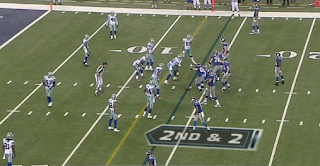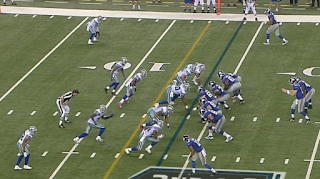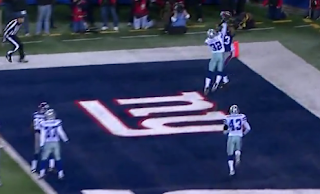Posted by Rafael at Tuesday, November 16, 2010
New Cowboys DC Paul Pasqualoni was one of Bill Parcells' guys. The former Penn State linebacker worked with the backers while the Tuna ran the shop, then followed Tony Sparano to Miami.
While in Dallas, he contributed to Big Bill's more ''measured'' 3-4. Not much blitzing. Play physical. Rush four, play a lot of zone behind it, and force the offense to beat you repeatedly in order to earn the end zone.
If his first defensive game plan can be considered a definitive one, Pasqualoni will return the Cowboys to the Parcells blueprint, and back down from the high-stakes, heavy blitzing that Wade Phillips preferred. That approach was tonic for a Cowboys secondary which was repeatedly exposed, beaten and demoralized in the Cowboys' three-game slide, which coincidentally began with the first Giants matchup.
Upping the Pass Rush Dosage
Let's look at two situations from that losing streak to see how Phillips' approach differed from the one Pasqualoni used Sunday.
October -- Giants @ Dallas
Late in the 2nd quarter the Giants have moved to the Dallas 15. They're in 2nd and 2 with just under a minute and a half left. Dallas leads 20-14. The eight yards on first down give the Giants a run-pass option, and Phillips sells out looking for a negative play. Note in the first slide how the Cowboys open in what looks like a quarters coverage look, with the safeties and the corners four-across, eight to ten yards off the ball:

Well before the snap, the Cowboys creep one of their inside linebackers and both safeties close to the line, tipping a max blitz. This is zero-coverage, meaning there are no safeties providing deep help. (Dallas has eight defenders within four yards of the line of scrimmage.) The Giants are in a posse set, meaning three WRs and one back. The Cowboys are matching their corners man up and have a linebacker taking TE Kevin Boss. They have to chase and hold and hope the Dallas rush gets to Eli Manning quickly:

The rush didn't get to Manning, a problem the Cowboys have suffered all year. Steve Smith broke past Orlando Scandrick's jam attempt and Manning floated a touchdown pass to him in the back half of the end zone.
Teams could see when Dallas intended to blitz, but Phillips didn't concede. He kept calling six and seven man blitzes which gave good quarterbacks shots up the field. Here's a similar situation two weeks later in Green Bay. On a 3rd-and-4, the Packers go with three wide:

Dallas bunched its d-linemen, both nickel linebackers and strong safety Gerald Sensabaugh at the line, tipping another heavy rush. Aaron Rodgers, sitting in the shotgun, keeps a back and tight end to block, knowing his three targets would have single coverage with little help. Rodgers threw to Greg Jennings wide left. Mike Jenkins had good coverage but no help. Alan Ball was playing deep middle and had to cover all three corners, waiting until the ball was thrown before pursuing. He could not get to the sideline in time. Rodgers dropped a perfect pass over Jennings' outside shoulder for a 33 yard gain.
The real culprit was the non-existent rush. Note how tight Green Bay's pocket is -- none of the six Cowboys rushers are making any penetration. Top quarterbacks like Rodgers and Manning can beat close coverage if they can set their feet and wait for the WR's patterns to develop. The repeated burnings were clearly wearing on all the corners.
continued . . .
New Cowboys DC Paul Pasqualoni was one of Bill Parcells' guys. The former Penn State linebacker worked with the backers while the Tuna ran the shop, then followed Tony Sparano to Miami.
While in Dallas, he contributed to Big Bill's more ''measured'' 3-4. Not much blitzing. Play physical. Rush four, play a lot of zone behind it, and force the offense to beat you repeatedly in order to earn the end zone.
If his first defensive game plan can be considered a definitive one, Pasqualoni will return the Cowboys to the Parcells blueprint, and back down from the high-stakes, heavy blitzing that Wade Phillips preferred. That approach was tonic for a Cowboys secondary which was repeatedly exposed, beaten and demoralized in the Cowboys' three-game slide, which coincidentally began with the first Giants matchup.
Upping the Pass Rush Dosage
Let's look at two situations from that losing streak to see how Phillips' approach differed from the one Pasqualoni used Sunday.
October -- Giants @ Dallas
Late in the 2nd quarter the Giants have moved to the Dallas 15. They're in 2nd and 2 with just under a minute and a half left. Dallas leads 20-14. The eight yards on first down give the Giants a run-pass option, and Phillips sells out looking for a negative play. Note in the first slide how the Cowboys open in what looks like a quarters coverage look, with the safeties and the corners four-across, eight to ten yards off the ball:

Well before the snap, the Cowboys creep one of their inside linebackers and both safeties close to the line, tipping a max blitz. This is zero-coverage, meaning there are no safeties providing deep help. (Dallas has eight defenders within four yards of the line of scrimmage.) The Giants are in a posse set, meaning three WRs and one back. The Cowboys are matching their corners man up and have a linebacker taking TE Kevin Boss. They have to chase and hold and hope the Dallas rush gets to Eli Manning quickly:

The rush didn't get to Manning, a problem the Cowboys have suffered all year. Steve Smith broke past Orlando Scandrick's jam attempt and Manning floated a touchdown pass to him in the back half of the end zone.
Teams could see when Dallas intended to blitz, but Phillips didn't concede. He kept calling six and seven man blitzes which gave good quarterbacks shots up the field. Here's a similar situation two weeks later in Green Bay. On a 3rd-and-4, the Packers go with three wide:

Dallas bunched its d-linemen, both nickel linebackers and strong safety Gerald Sensabaugh at the line, tipping another heavy rush. Aaron Rodgers, sitting in the shotgun, keeps a back and tight end to block, knowing his three targets would have single coverage with little help. Rodgers threw to Greg Jennings wide left. Mike Jenkins had good coverage but no help. Alan Ball was playing deep middle and had to cover all three corners, waiting until the ball was thrown before pursuing. He could not get to the sideline in time. Rodgers dropped a perfect pass over Jennings' outside shoulder for a 33 yard gain.
The real culprit was the non-existent rush. Note how tight Green Bay's pocket is -- none of the six Cowboys rushers are making any penetration. Top quarterbacks like Rodgers and Manning can beat close coverage if they can set their feet and wait for the WR's patterns to develop. The repeated burnings were clearly wearing on all the corners.
continued . . .


